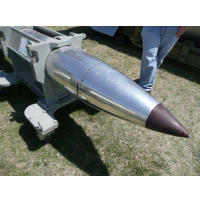Upgrading U.S.’s 5,000 Nuclear Warheads Could Cost Hundreds of Billions of Dollars
 B61 nuclear bomb (photo: Vladimir Yakubov)
B61 nuclear bomb (photo: Vladimir Yakubov)
Twenty years after the Cold War ended, the U.S. finds itself with an aging stockpile of nuclear weapons and delivery systems that must be upgraded or replaced if the government wants to still have a working deterrent.
Lawmakers and presidential administrations have put off addressing the problem due to its enormous financial costs.
One nongovernmental assessment, from the nonpartisan Stimson Center, projected that Washington might need to allocate $352 billion over 10 years to keep the nuclear arsenal of 5,113 warheads working effectively in the coming decades. This includes an estimated $66 billion just to modernize the buildings and laboratories where the upgrades would take place.
Even tackling the problem one bomb at a time could prove prohibitively expensive. The B61 nuclear bomb, of which there are about 500, will require $10 billion in upgrades over five years.
The most expensive task, according to the Congressional Budget Office, will be replacing the aircraft, submarines and ground-launch missiles that carry nuclear payloads.
For instance, the Ohio-class nuclear submarine is now three decades old. Replacing it with a newer model could cost $110 billion for just 12 subs.
-Noel Brinkerhoff
To Learn More:
Aging U.S. Nuclear Arsenal Slated for Costly and Long-Delayed Modernization (by Dana Priest, Washington Post)
The B61 Bomb: A Case Study in Costs and Needs (by Dana Priest, Washington Post)
- Top Stories
- Unusual News
- Where is the Money Going?
- Controversies
- U.S. and the World
- Appointments and Resignations
- Latest News
- Musk and Trump Fire Members of Congress
- Trump Calls for Violent Street Demonstrations Against Himself
- Trump Changes Name of Republican Party
- The 2024 Election By the Numbers
- Bashar al-Assad—The Fall of a Rabid AntiSemite






Comments